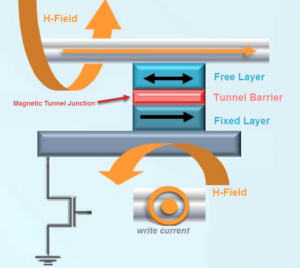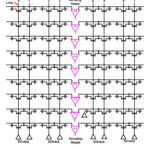There are two basic types of memory: volatile and non-volatile. Volatile memory loses its content and becomes a blank slate whenever power is completely removed. However, volatile memory doesn’t need much power and can maintain its contents with a small battery. Non-volatile memory retains its contents even if power is completely removed.
SRAM and DRAM
Volatile types of memory include Static RAM (SRAM) and Dynamic RAM (DRAM), which are in wide use as working memory for CPUs. SRAM is reliable and fast, with access times from 10 to 30 ns. DRAM access time is typically 50 – 60 ns. DRAM uses capacitors and needs to be refreshed as the capacitors used to store data lose charge over time. SRAM does not require refresh, but like DRAM needs a constant power supply to avoid losing stored data. DRAM is typically used as the main working memory for the CPU in a computer, whereas SRAM is used for caches and other applications needing high-speed registers.
NVRAM
A synopsis of types of Non-volatile Random Access Memory (NVRAM) follows:
Technically non-volatile memory, punch cards were the earliest mainstream form of storing data on media, followed by magnetic tape and floppy disks. The floating gate memory cell was the first instance of NVRAM. Floating gates are transistors that hold one bit (0 or 1) of memory by either holding a charge or not.
The difference between EPROM and EEPROM
An EPROM (Erasable Programmable ROM) can be written to but needs to be exposed to UV light through a window in the package in order to be erased. In wider use today is the Electrically Erasable Programmable ROM (EEPROM) chips, which are re-writeable integrated chips (ICs) that keep data when power is removed and erase data with an electrical signal. In order to write to an EEPROM, you have to erase it first. EEPROMs can be addressable by the bit or the byte (8 bits), so different lengths of data can be retrieved. EEPROMs are most often used for storing small amounts of onboard data, such as boot code.
ROM, PROM, FROM, and OTP NVRAM
Another type of non-volatile memory is Read Only Memory (ROM), which includes Programmable Only Memory (PROM) which is programmable once after manufacture and locked by way of a fuse; Field Programmable Memory (FPROM), which is also programmed after manufacture; and One-Time Programmable Non-Volatile Memory (OTP NVRAM), which is an EPROM without a window for UV exposure and erasure, which reduces cost.

Flash Memory
Arrays of floating gates in either a logical NOR or NAND arrangement make flash memory. Flash memory shares many of the same technical attributes as EEPROM. However, Flash can retrieve entire blocks of memory at a time, whereas EEPROMs can only retrieve bits or bytes with each fetch instruction. Flash memory is typically used to store large amounts of data from devices such as digital cameras and is also used as a faster replacement for a computer hard drive (HDD). NAND Flash-based memory is used to replace traditional hard drives as primary storage on computers as a solid-state drive (SSD). There are two types of flash memory: NAND and NOR. NAND flash technology can read faster than it writes and is more can fit in the same area than NOR-based flash. Flash memory has become portable with USB memory sticks, SD cards, and other interface technology that are used to access flash.
Newly emergent NVRAM
New NVRAM technologies have appeared in shelves in just the past decade or so. Ferroelectric Random Access Memory (FRAM, F-RAM, or FeRAM) is another non-volatile memory technology that writes extremely fast, has high endurance, and is power efficient. According to Texas Instruments, “The actual write time to a FRAM memory cell is less than 50 ns. That is approximately 1000x faster than EEPROM. Additionally, unlike EEPROM where you must have two steps to write data: a write command, followed by a read/verify command; FRAM’s write memory function happens in the same process as reading memory. There is only one memory access command, one step for either reading or writing.” FRAM also uses on the order of 1.5 V versus the 10-14 V that EEPROM requires. FRAM is also reliable and has a R/W endurance of up to 100 trillion cycles. FRAM is also secure because it’s more resistant to data corruption from outside influence and has the same power consumption signature for a read as it has for a write. FRAM is not affected by magnetic fields. FRAM is actually fairly radiation-resistant compared to others. Therefore, FRAM is quickly becoming a favorite in medical and automotive industries.
MRAM (magnetoresistive random access memory) is an NVRAM technology that stores data using magnetic state. MRAM is vulnerable to external magnetic fields, however external shielding of the MRAM at the package level mitigates hazards related to exposure.
What is the difference between FRAM and MRAM?
Everspin Technologies is a primary producer of MRAM. According to Everspin, “MRAM or Magnetic Random Access Memory uses a 1 transistor – 1 magnetic tunnel junction architecture with the magnetic “state” of a ferromagnetic material as the data storage element. Because MRAM uses a magnetic state for storage (rather than charge which can ‘leak away’ with time), MRAM offers significantly long Data Retention (+20 years) and unlimited endurance.”[i] Everspin uses standard CMOS technology to produce MRAM. It’s as yet unclear whether MRAM or FRAM will become dominant as prices come down over time. Until then, low-cost flash memory (such as NAND) will retain prominence in SSDs, USB thumb drives, and SD cards.

Future memory technologies
Future memory technologies, or memory technologies that provide promising research, include spin-transfer torque random-access memory (STT-RAM), phase-change memory (PCM), and resistive random-access memory (RRAM). MRAM and FRAM are very new and doubtless, have improvements to come. Memory technology is also being explored with the possibility of memristors. New classes of memory, already under research and development, may someday include plastics, quantum dot memory, three-dimensional memory, and organic/biological based memory.[ii]
[i] Bohac, Chuck. Comparing Technologies: MRAM vs. FRAM . 2013, pp. 1–7, Comparing Technologies: MRAM vs. FRAM .
[ii] Meena, Jagan Singh, et al. “Overview of Emerging Nonvolatile Memory Technologies.” Nanoscale Research Letters, Springer, 25 Sept. 2014, .


Leave a Reply